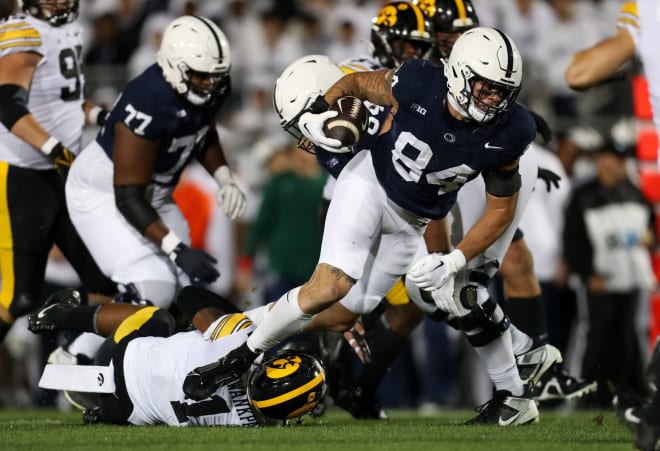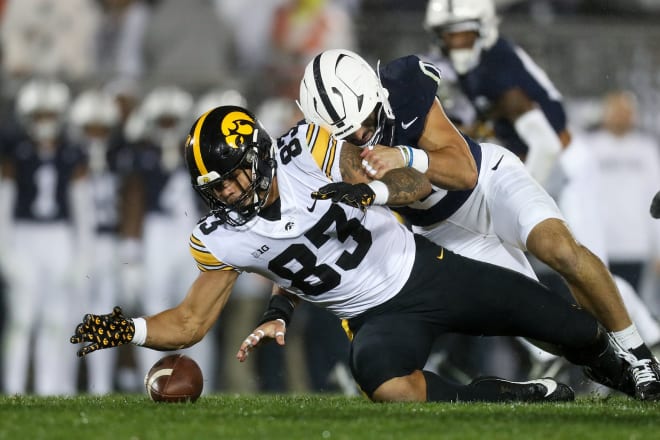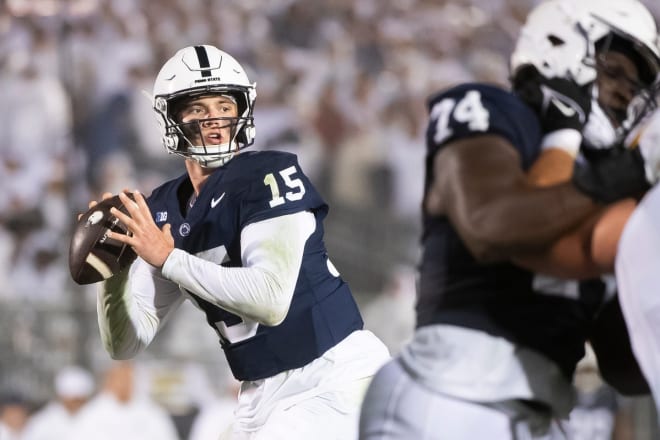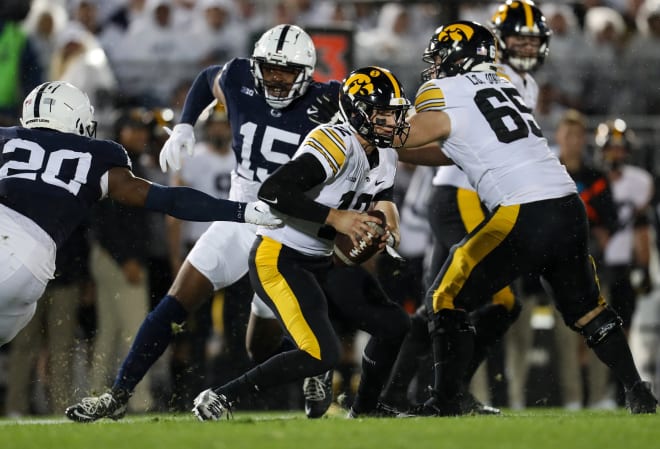Five Takeaways: Penn State 31, Iowa 0

#7 Penn State (4-0, 1-0 Big Ten) demolished #24 Iowa (3-1, 0-1 Big Ten) on Saturday night, 31-0. What are the five biggest takeaways from that performance?
IOWA IS NO LONGER COMPETITIVE WITH THE BIG TEN'S BEST
Iowa's ability to compete with -- and, at times, beat -- the Big Ten's best has been one of the hallmarks of the Kirk Ferentz Era at Iowa. It's no small part of why Ferentz is in his 25th season as Iowa's head coach.
The wins include some of the greatest moments of Ferentz's tenure -- the 2008 and 2009 upsets of Penn State, the 2016 win over Michigan, the 2017 thrashing of Ohio State, to list a few. Even when Iowa lost to those teams, it was often in close fashion, such as the narrow losses to Penn State in 2017 and 2018 or to Ohio State in 2009 and 2010.
Iowa's losses to those programs are no longer close -- they're not even competitive. Since Iowa's 23-20 win over Penn State in 2021, the Hawkeyes have been outscored 154-27 in four games against Michigan, Ohio State, and Penn State.
2021: Michigan 42, Iowa 3 (Big Ten Championship Game)
2022: Michigan 27, Iowa 14
2022: Ohio State 54, Iowa 10
2023: Penn State 31, Iowa 0
Even the closest game on that list -- the 27-14 defeat to Michigan last season -- wasn't actually that close. Michigan led 20-0 before Iowa managed to score and the Hawkeyes' second touchdown came with 8 seconds remaining in the game.
Iowa has scored three touchdowns in those four games and only one of those touchdowns (Joe Evans' 11-yard scoop-and-score fumble recovery against Ohio State) came outside of the fourth quarter. The only two touchdowns by the Iowa offense came in the 2022 Michigan game and with the game largely out of reach. (Kaleb Johnson's TD run against Michigan in 2022 cut Iowa's deficit from 20-0 to 20-7 with the entire fourth quarter to play, but that still left Iowa effectively in need of a miracle comeback -- Michigan's win probability went from 99.1% to 96.3% after that score and never dipped below 91% in the fourth quarter.)
The defense has had some issues of its own in Iowa's recent lopsided losses to Michigan, Ohio State, and Penn State -- namely an inability to get key stops or force turnovers -- but the overwhelming source of Iowa's shortcomings in those defeats has been on the offensive side of the ball. The Hawkeyes can't score points and (increasingly) can't even move the ball or possess it for any longer than the bare minimum amount of time it takes to run three plays and punt.

THE TREND OF OFFENSIVE INEPTITUDE IS NOT CHANGING
Since that 23-20 win over Penn State in 2021 -- a win that vaulted Iowa to #2 in the AP rankings -- the Hawkeye offense has completely imploded. Iowa has played 25 games since that win and the Hawkeyes have failed to score at least 10 points in seven of those 25 games. If you raise the threshold to 20+ points, Iowa has failed to hit that mark in 13 of its last 25 games.
Iowa has also failed to exceed 200 yards of offense in seven of its last 25 games. Iowa has managed to top 300 yards of offense just seven times in those 25 games. The Iowa offense has been among the nation's worst at moving the ball.
To put Iowa's numbers in context, the Hawkeyes are averaging 18.2 points per game over their last 25 games. That would rank 123rd in the nation this season. The Hawkeyes are also averaging 264 yards per game over their last 25 games. That would rank them 131st in the nation this season -- which, coincidentally, is where their offense does rank at present, while averaging 245.5 yards per game. Statistically speaking, Iowa has had one of the worst -- and least-effective -- offenses in the country over the last 25 games.
This is not merely a function of playing elite defenses, either. Penn State does have an elite defense -- the Nittany Lions actually moved up to #1 in total defense after holding Iowa to just 76 yards -- but Iowa was far worse offensively than PSU's previous opponents. West Virginia and Illinois both exceeded 300 yards of total offense against Penn State, while even FCS Delaware ended up with 140 yards of offense.
Likewise, Iowa State has a very good defense -- currently ranked #20 in total defense -- but every other ISU opponent has surpassed Iowa's total of 235 yards against the Cyclones. More damning are the results from Utah State and Western Michigan. Unlike PSU and ISU, Utah State and Western Michigan don't have good defenses -- they currently rank 105th and 108th nationally in total defense -- and yet their best defensive games of the season have been against Iowa.
Utah State has allowed over 400 yards of offense and 5.0 yards per play to all of its non-Iowa opponents this season; Iowa managed just 284 yards and 4.1 yards per play against the Aggies. The only team to gain less than Iowa's 387 yards of offense against WMU was NAIA St. Francis (PA), who had 281 yards against the Broncos. Syracuse and Toledo, WMU's non-Iowa FBS opponents so far this season, each racked up nearly 500 yards of offense and 48+ points against the Broncos.
In fact, Penn State, Iowa State, Western Michigan, and Utah State have combined to play 12 opponents other than Iowa this season; 11 of those 12 opponents out-gained Iowa in their respective games against PSU, ISU, WMU, and Utah State. Most out-gained Iowa by a substantial margin.
The glacial pace of the Iowa offense contributes to Iowa's low total yardage outputs, but the Iowa offense isn't effective on a per-play basis, either. PSU, WMU, and Utah State all posted their best defensive performances on a yards per play basis against Iowa as well.
Iowa changed a substantial amount of player personnel on offense ahead of the 2023 season, adding Cade McNamara, Erick All, Kaleb Brown, Seth Anderson, Rusty Feth, and Daijon Parker through the transfer portal. Despite a few flashes of success, the overall impact of all those transfer additions to Iowa's offensive production has been negligible.
The Iowa offense was very bad last year -- and it's still very bad this year. The problems with the offense go much deeper than the players running it. Until Kirk Ferentz reckons with those issues, Iowa's offense is likely to remain one of the nation's worst.

THE TURNOVER PROBLEM
One of the things Iowa needed to do to have a shot at beating Penn State last night was protect the ball and win the turnover battle. To put it mildly, that did not happen. Iowa turned the ball over four times and forced zero turnovers from Penn State. All of Iowa's turnovers came via fumbles -- the Hawkeyes put the ball on the ground six times and lost four of them.
On one hand, there's certainly some bad luck involved in Penn State recovering so many Iowa fumbles, especially when the only Penn State fumble in the game was also recovered by the Nittany Lions. None of the breaks went Iowa's way against Penn State.
On the other hand, you also cannot fumble the ball six times. At one point, Iowa fumbled the ball on back-to-back plays, recovering the first and losing the second. There was an element of misfortune in some of the fumbles -- particularly in the fumble that resulted from a poor Penn State punt deflecting off an Iowa gunner on a punt return. But six fumbles don't happen without sloppy ball-handling and poor awareness. (Poor blocking was also a contributing factor, as Iowa linemen got abused by Penn State on strip-sacks in the second half.)
The turnover issue also speaks to a bigger issue with this team, though -- turnover margin has turned against the Hawkeyes in a big way this season. Iowa is currently tied for 111th in the country with a -4 turnover margin. Iowa has given the ball away seven times in four games, while forcing just three turnovers themselves.
Both sides of that margin are cause for concern. Averaging almost two turnovers per game is not a winning formula for Iowa. But the inability to force turnovers might be even more concerning. Iowa has forced just three turnovers all season, including only two interceptions.
The Iowa defense has been one of the nation's best at forcing turnovers and getting interceptions in recent years (Iowa had 20+ interceptions in three of last five full seasons prior to 2023), but that has dropped off so far this season. That's a major problem for a team as reliant on takeaways as Iowa.

THE DEFENSIVE LINE PRESSURE (OR LACK THEREOF)
As it turns out, losing Lukas Van Ness and Noah Shannon (as well as John Waggoner) from last year's defensive line has had a much bigger impact on the effectiveness of that unit than we anticipated. The defensive line has struggled to generate consistent pressure on quarterbacks all season. Iowa ranks 128th nationally with three sacks in four games; only Sam Houston State (2.0 sacks) has fewer so far this season.
Against Penn State, Iowa again recorded zero sacks. The Hawkeyes were credited with 14 QB pressures against the Nittany Lions by Pro Football Focus -- 11 QB hurries and 3 QB hits -- but in the context of Penn State running 41 pass plays, that means that Iowa was unable to generate any pressure on the QB on two-thirds of PSU's pass plays.
The eye test seems to back that up as well -- Iowa rarely forced Drew Allar into a bad decision or a rushed throw last night. Unfortunately, that's been a common trend for Iowa this season; the defense needs to find ways to generate more pressure on quarterbacks, whether that's via increased blitzes or some of the younger DL options making some rapid in-season improvements. Until that happens, the Iowa defense will probably continue to give up too many long drives and struggle to force turnovers.

OFFENSIVE LINE WOES
There are, obviously, a host of problems with the Iowa offense. The play design struggles to create open receivers. The playcalling often fails to find any sort of a workable rhythm. The involvement of wide receivers in the offense is almost nonexistent at times. But one underlying problem for the Iowa offense over the last few seasons has been the poor play of the offensive line.
Problems with the offensive line contribute to problems throughout the offense; running backs can't run if there are no holes and the passing game can't click if the QB is constantly under pressure. There were a few positive signs for the offensive line earlier in the season -- better pass protection in the first few weeks, strong run blocking against Western Michigan -- but last night's game was a big step backward.
The quality of Penn State's defense -- and the defensive line in particular -- was certainly a factor in Iowa's struggles, but it doesn't account for the inability of Iowa's offense to do anything after the first two drives of the game. After those first two drives, the line struggled to open holes in the running game and they struggled to slow down Penn State's pass rush. Chop Robinson was able to almost camp out in the Iowa backfield.
"Inexperience" has been a frequent explanation for the struggles of the offensive line, but as CBS analyst Gary Danielson noted during the broadcast last night, several members of that starting OL unit have at least 20-25 college starts at this point. That's a fair amount of experience, especially at the college level. It shouldn't take 30+ starts for an offensive line to be at least decent. What Iowa is doing on the offensive line -- and has been doing in recent years -- clearly isn't working.